North America in the late Cretaceous was home to some of the most famous and iconic dinosaurs. Here, in the vast landscape, huge herd of the most famous ceratopsian, Triceratops, congregated in their annual mating season.Triceratops in huge numbers dominated the landscape as other dinosaur gave way, perhaps overwhelmed by the shear number of the loud and boisterous groups. Huge males starts to visually size up potential rivals as they start to claim small territory that they would defend against other males. At this early stage, loud grunts and warning calls are enough to keep the animals at a safe distance from each other.
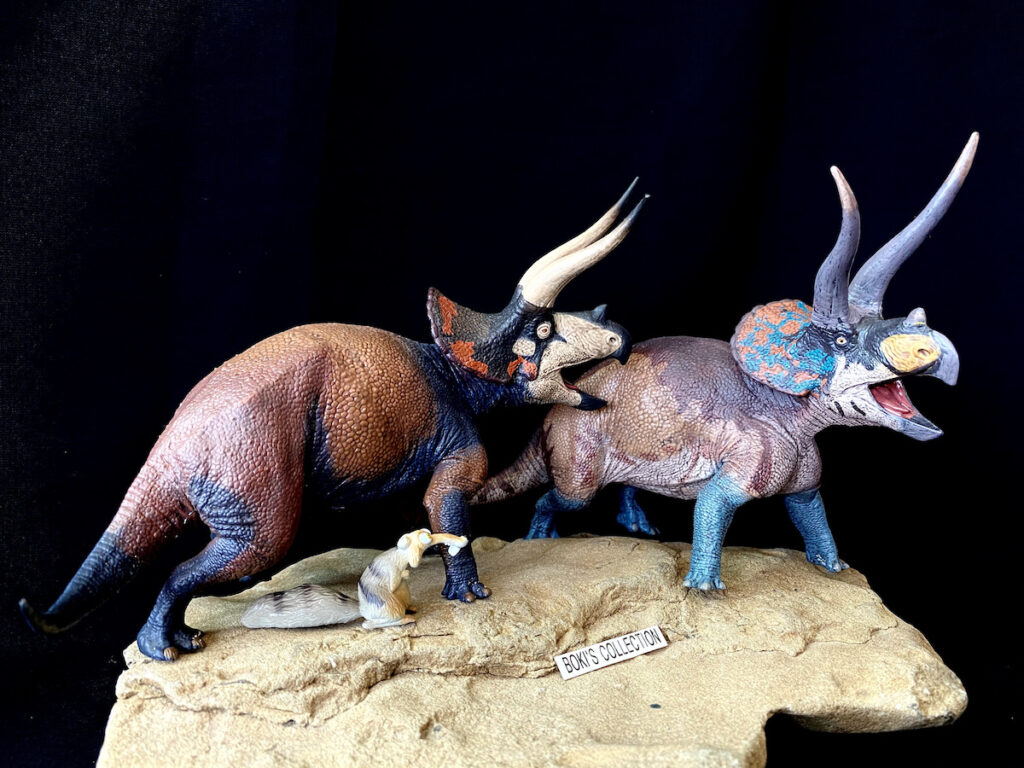
As the season progress, vocalization turns into more physical challenges as the largest of the males starts to spar with each other, their large impressive horns making loud sound as they clash.This sparring consumes the male’s attention that they often only focus on their rival, abandoning any sense of being alert and aware of their surroundings. This preoccupation is exactly what Tyrannosaurus, the largest and apex predator of the land, is waiting for.
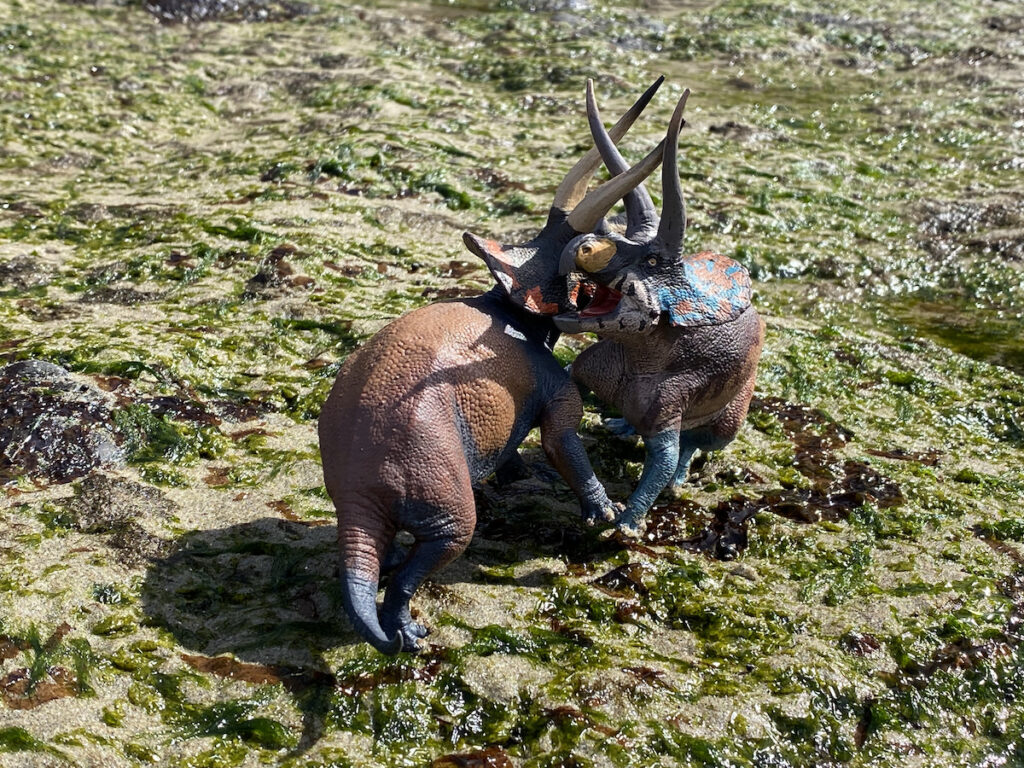
Near the coast, two large males can be seen displaying, circling and seizing up each other first. Equally matched, they soon run towards each other with their horns and head pointed down and forward in an attack mode. One of the animals is a young adult not yet fully showing its full colors, but he is of equal size to the dominant male he is challenging. Soon, the two males are pushing at each other, their long impressive horns delicately locked as they try to throw the other off-balance. Unknown to them, a full-grown Tyrannosaurus is lurking, hidden, and has been watching them from a distance looking for signs of an opportunity to attack and has now crept up close enough to make his move.
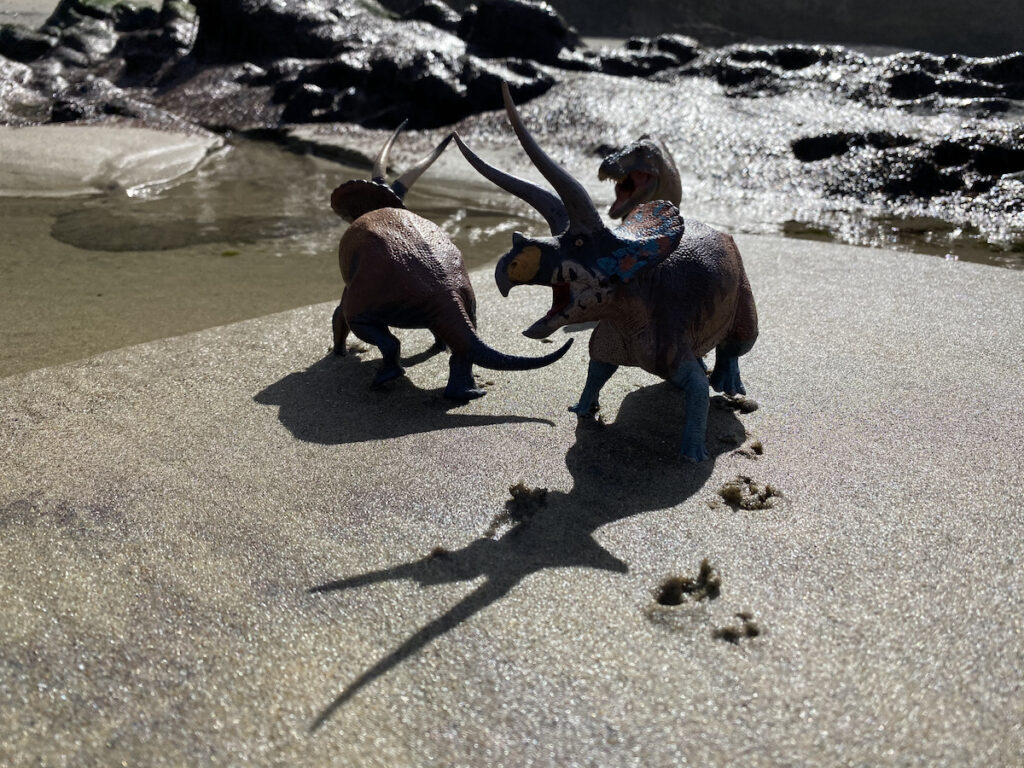
The predator stumbles and his presence is soon exposed by the commotion.The battling pair of Triceratops noticed the large figure approaching and soon the duo are no longer fighting with each other as they disentangle themselves from each other and run for their life towards the safety of the open plain and the herd!

Triceratops and Tyrannosaurus are two, if not the most, popular dinosaurs of all time, in fact you can’t mention one without also mentioning the other. Their story and image are forever intertwined with each other in our minds and pop culture for decades that it would be hard to separate the two even if we try.So, for this review, I tried something different and do a photo-essay type and as a homage for their iconic status, also featured PNSO’s Wilson V3 (they really do go so well together!) in many of the photos.
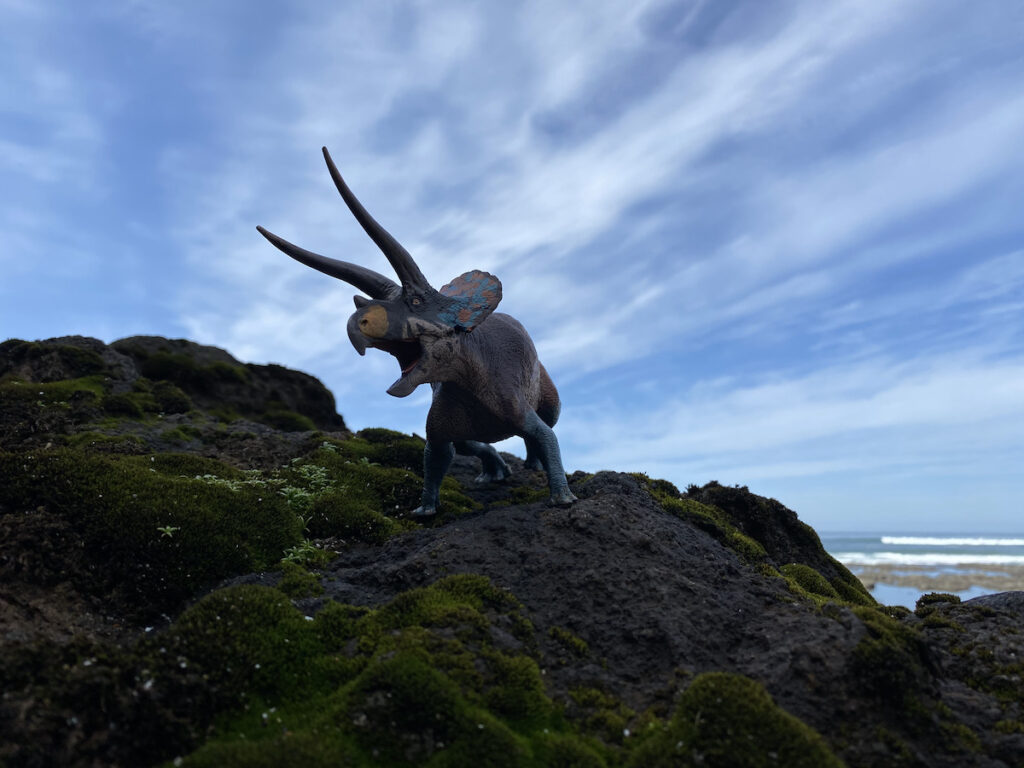
For the purpose of this review’s story, I decided that both are adult males, but one of them (the Dominant morph) is not yet showing its full breeding colors (Cryptic morph). The photos ( taken in a story board format) follows and tells the story of these two as they fight for dominance as well as facing the ever present threat from large predators.
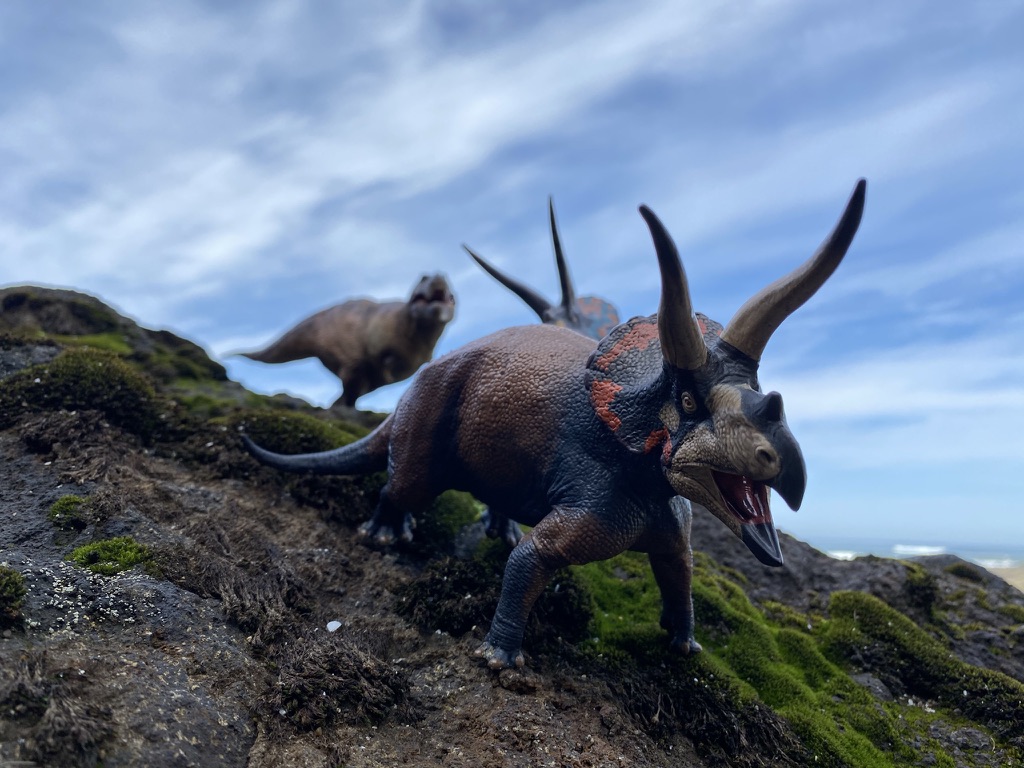
Triceratops is one of those dinosaurs that needs no introduction since it is so well know, but this particular model is based on a unique specimen that warrants a quick mention.While the majority of Triceratops represents either Triceratops horridus or Triceratops prorsus , the two recognized valid species ( or even the disputed Torosaurus), this model is based on a yet to be described Triceratops species informally known as ” Yoshi’s Trike” (after it’s discoverer Yoshi Katsura) currently on display at the Museum of the Rockies in Montana .
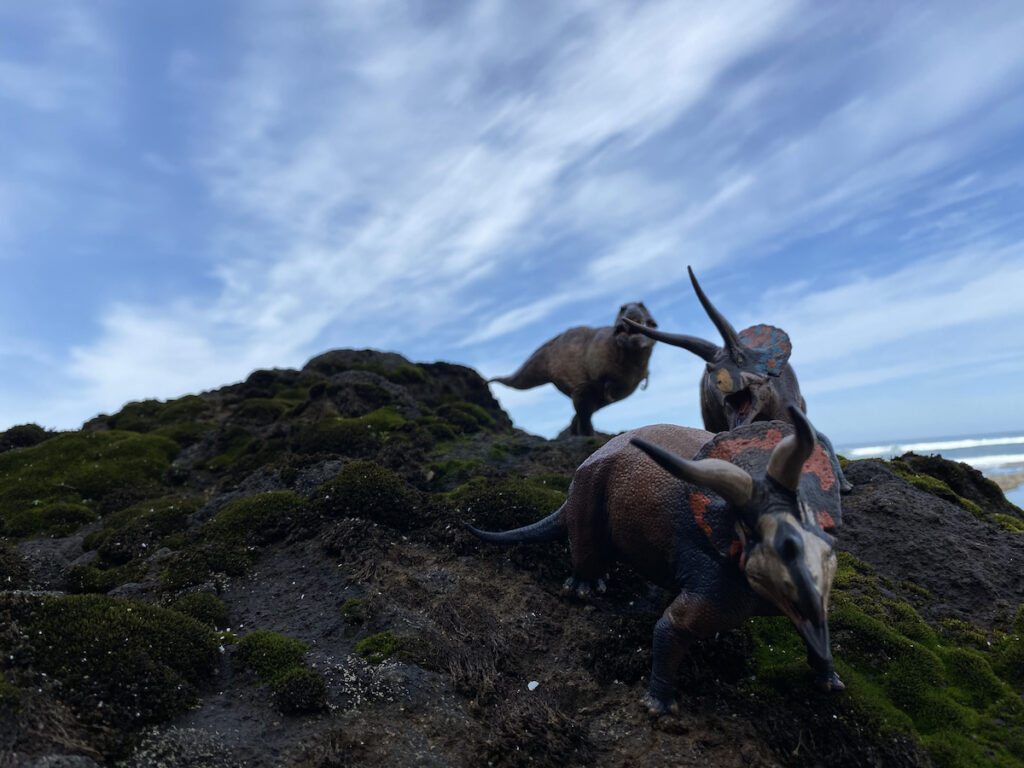
So, why would Eofauna chose an unknown Triceratops species instead of the known ones? As it turns out, this Triceratops Sp. has a unique feature that sets it apart from all others.”Yoshi’s Trike” (MOR 3027) holds the record of having the longest horns of any known Triceratops and also it was a very large young individual. These impressive horn core measures nearly four feet long in length! I have to admit I was not aware of this Triceratops before, so my first reaction upon seeing photos of this figure is that the horns looked really long and out of scale for the model.Another interesting fact about this Triceratops is that it is older than either Triceratops horridus or Triceratops prorsus but shares some characteristic of both of it’s famous cousins and could very well be the transitional form between these two known species. Only further study and full description would tell.
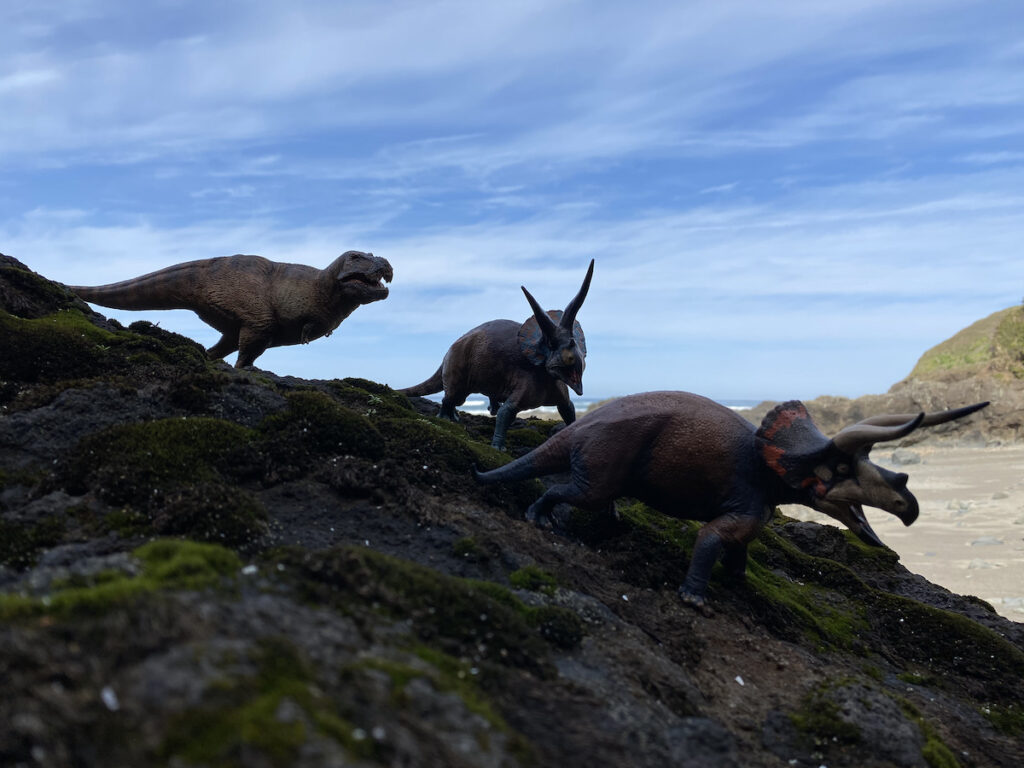
The Triceratops figure is Eofauna’s third dinosaur joining Giganotosaurus and Atlasaurus and sculpted at the same 1:35 scale so they all display nicely together.The Triceratops figures are the same sculpt but comes in two different, unique, and distinct color options: Dominant and Cryptic. These two different colors give collectors an option, and if you do get both, you can have one be a female and the other a male or two individual males in different maturation phase. I’m a little confused by the choice of name for these two color choices; to me, it seems like the “Cryptic” should have been the dominant and vice versa.The eyes on both figures are the same golden orange color and very precisely painted with no messy edges. Let’s take a look at the color differences of each variant individually before we move on.
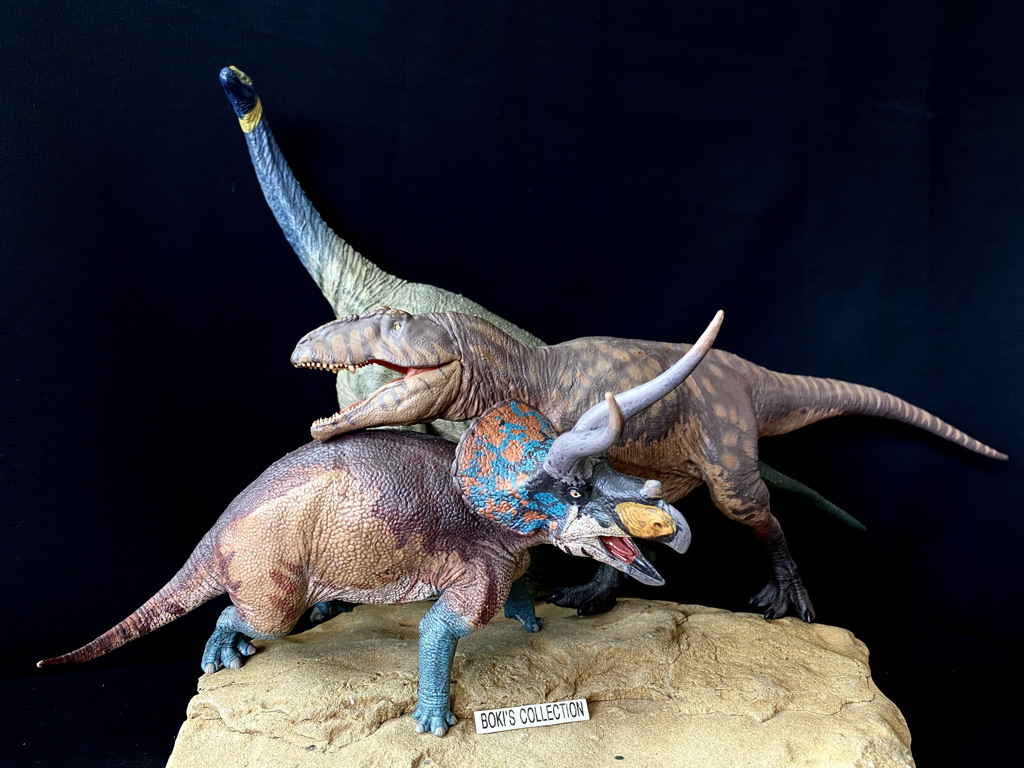
Dominant – On this version, the overall body color is a Chestnut brown with lighter yellow and orange highlights here and there. Breaking this color is a very dark bluish-gray band that starts at the frill and head then moves down the neck and shoulders, then continues down the belly area creating a “U” silhouette on the stomach. The legs are also disrupted by this same color starting at the knee; we see the tail split between the Chesnut brown and the dark brown colors almost evenly. This dark band is almost black at first glance but look closer and you will notice that there is a subtle blue hue mixed in with it adds depth.
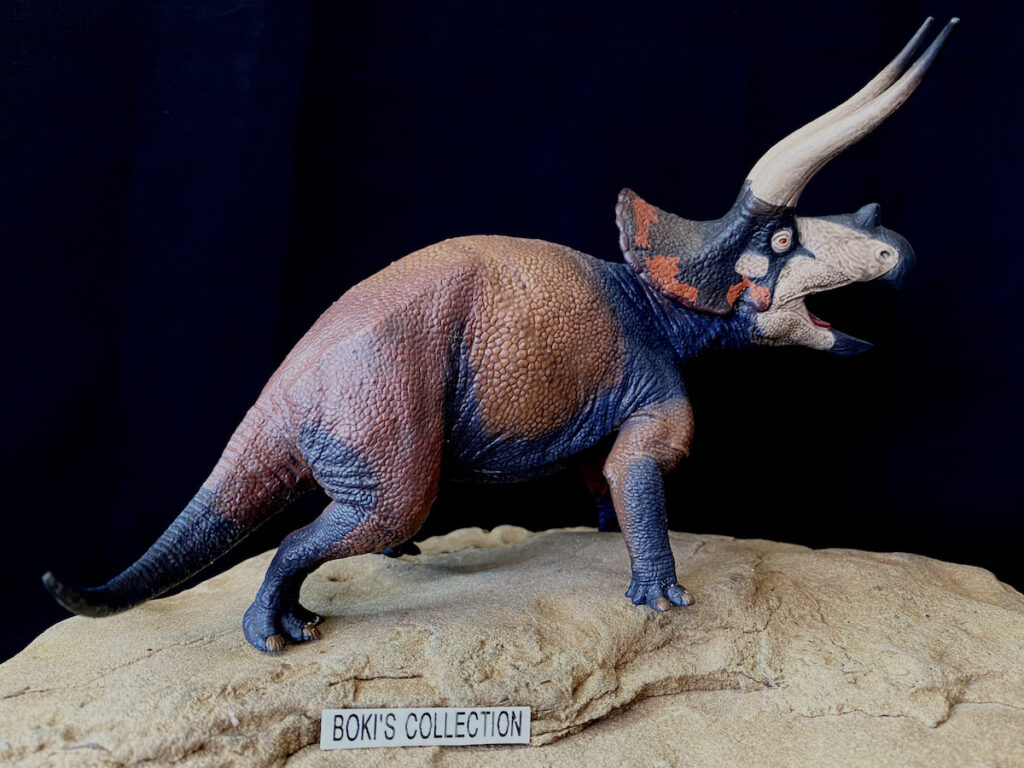
On the face, a cream /dirty light brown color dominates the half of the face all the way to the snout. There are two spots of the same color on the side of the face with one encircling the eye. The lower half of the horns are also colored with the same cream shade and it slowly and beautifully transitions to an almost black color as it reaches the tips. The ridge of the snout as well as the beak is colored black.A splash of orange in the form of spots of various shapes and size adorn the frill.
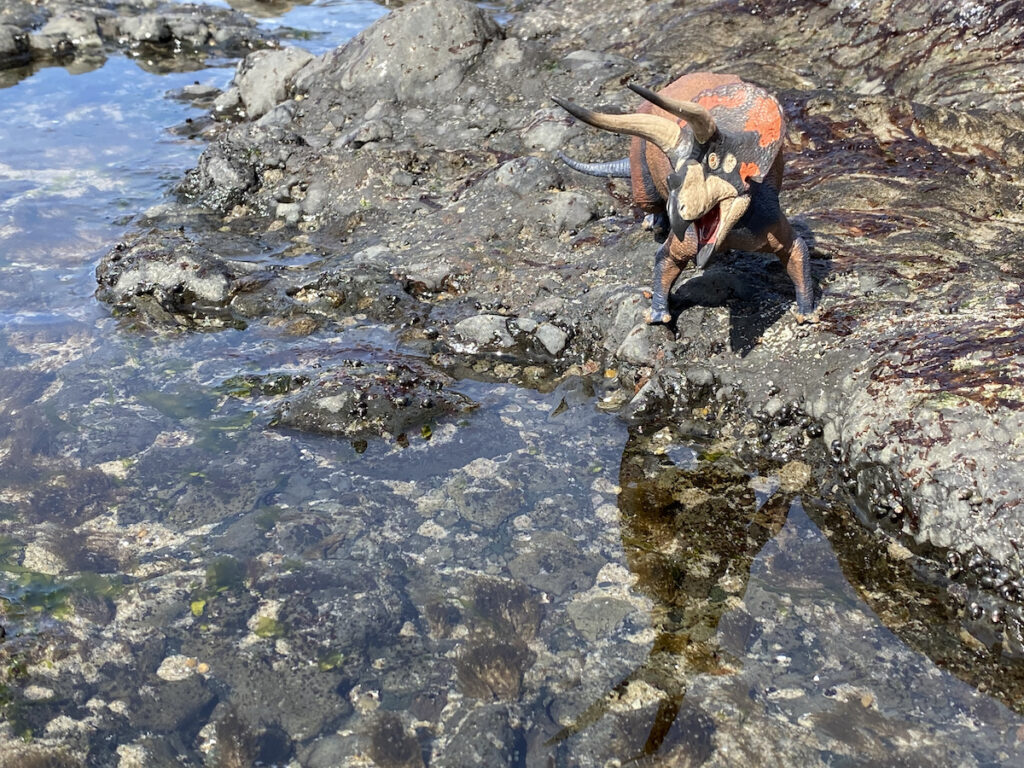
Cryptic – This version is the more colorful with more complex design of the two. The main body color is a lighter shade of brown with various shades of tan and orange highlights all over the body. There is also a dark chocolate brown band that disrupts the main body color, but this time it starts off at the back like a huge saddle starting at the neck that radiates towards the upper half of the back and runs all the way down towards the tail. This band also runs down halfway down the legs in various stripes and spots.

Beginning at the throat, a tan color dominates the lower part of the head just above the upper jaw and continues down towards the belly and stomach side, as well as the underside of the tail. As it travels down the body and meets up with the other colors, it creates a pleasing transition from the brighter colors and the darker tones.The upper part of the head is also colored chocolate brown, but there is a bright yellow spot on the snout that is separated by a narrow and small grayish spot of gray color which can also be seen on both the upper and lower beak. The horns are grayish in color starting at the base and transitions to a lighter brown tone at the tips.The frill is adorned by the same oddly shaped orange spots seen on the Dominant version, but in addition, there is also a turquoise blue spot that meanders between the orange ones that really is very striking.
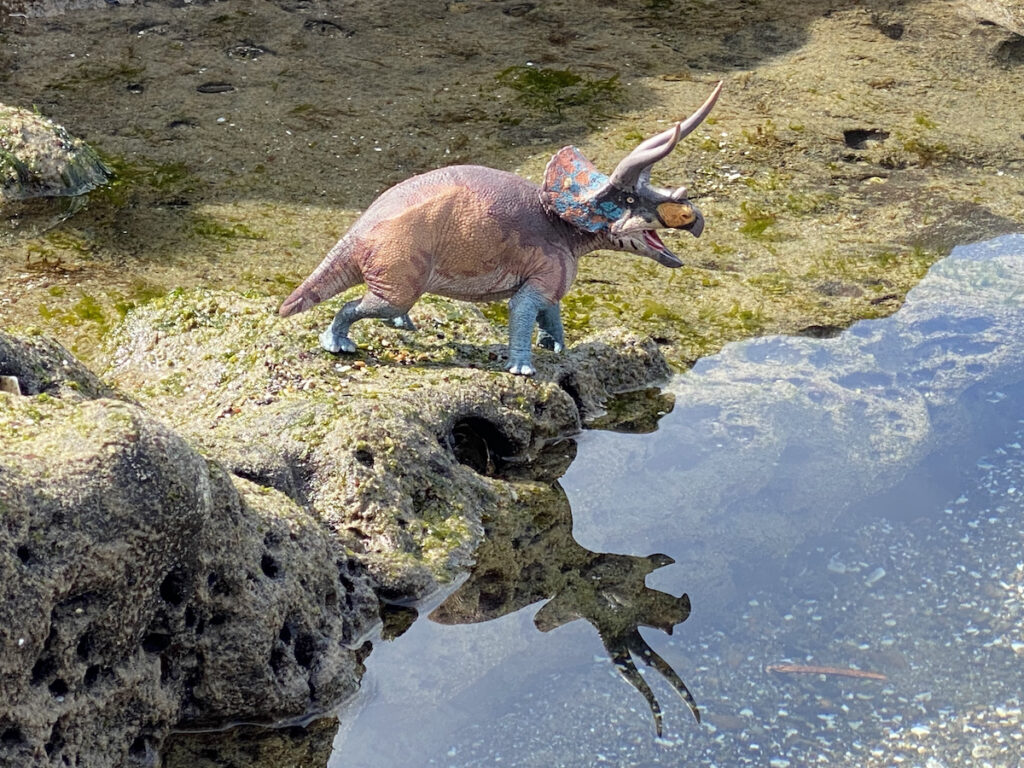
This same turquoise color is used on the legs bringing it all together impressively. There are also dark brown stripes along the face.Now, I have to admit that when I first saw promo pictures of this turquoise colors, I was doubtful of the mix and not at all convinced it will work that I almost didn’t get it.Part of the problem was the majority of promo photos made this color too saturated and almost greenish in color. But in person, I was very impressed by how much different it was from the promo photos, it actually looks very well mixed and had a cool and very pleasing effect that is hard to describe. This impressive execution of this difficult color (blue is very difficult color to use and handle especially when used on animals, it is also hard to photograph it without it looking too saturated) is a testament of how well the artist handle color combination and mixing them to create a pleasing tapestry of colors. Despite my initial doubts, the Cryptic version quickly became my favorite of the two.
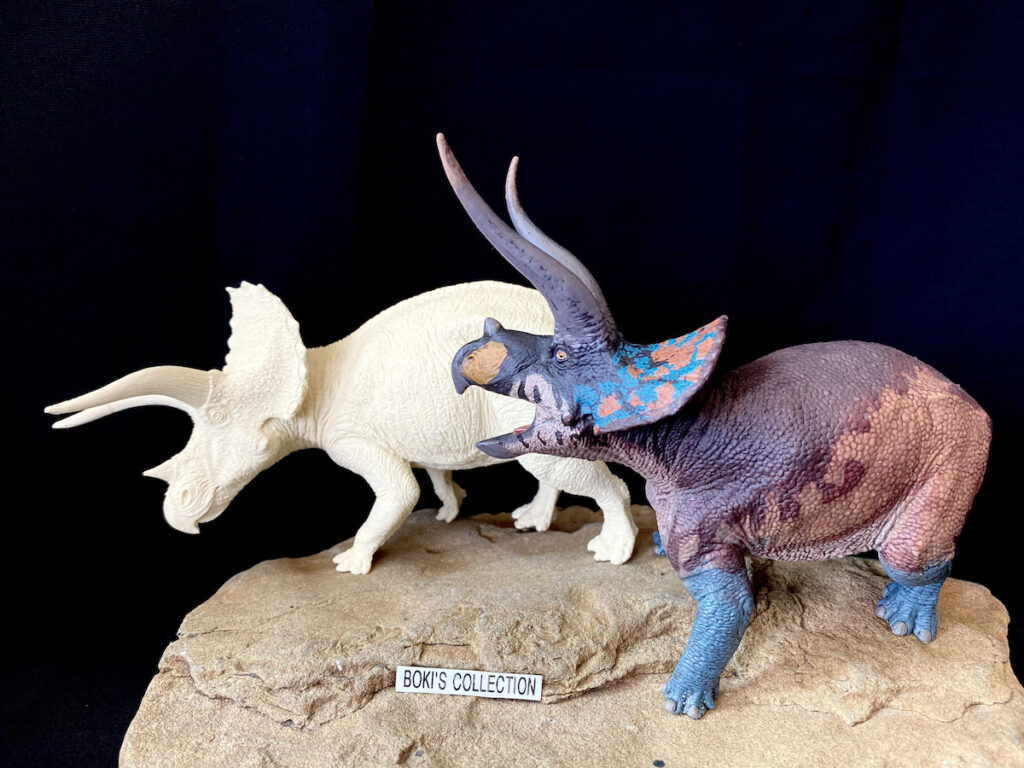
The Eofauna model is one of the most dynamically posed Triceratops to have ever hit the market. With the exception of articulated figures, most Ceratopsians are posed in a neutral pose, or at the least at the minimum with its head lowered.Eofauna gave their model a really active pose without looking too contrived that is both convincing as well as flexible as far as how you would like to interpret it. If you have both version they can be paired in a sparring pose that is very impressive!
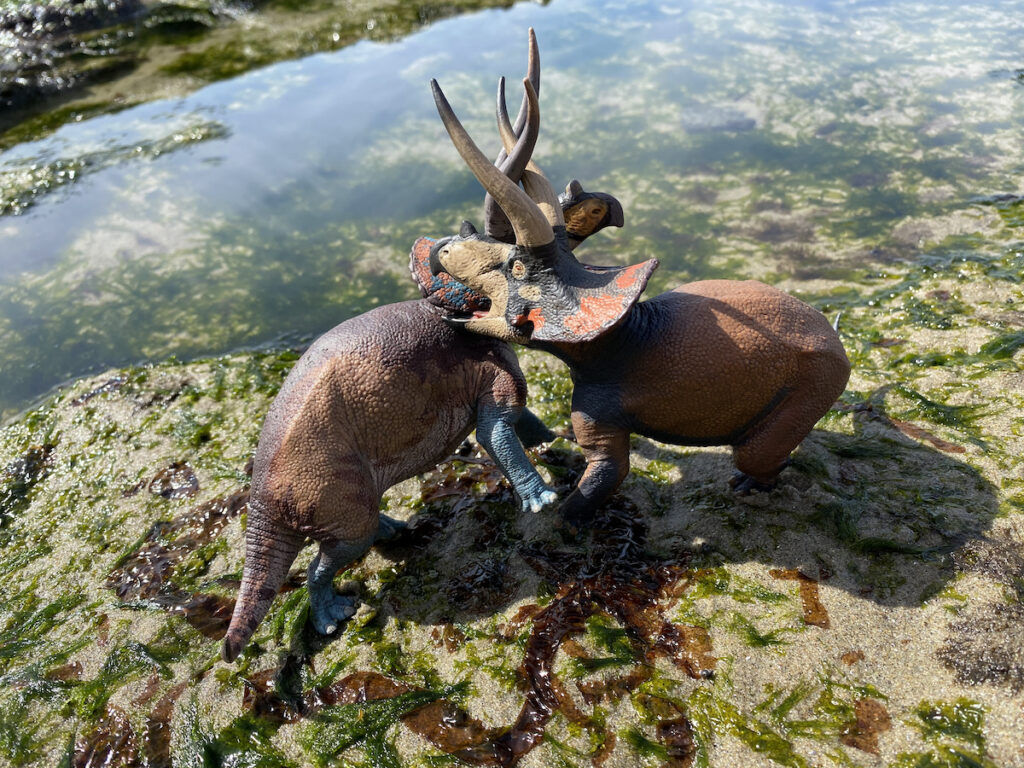
The head is turned slightly to the right with its mouth wide open. Inside the mouth, you can see clearly the details such as teeth and tongue, all beautifully sculpted.Its body is also twisted sideways as if looking back or about to charge a rival. Its legs are firmly planted on the ground with the left front thrust forward and the left pulled back. The back legs are in the same position giving the figure a real sense of active fluid motion that is natural and not contrived looking.
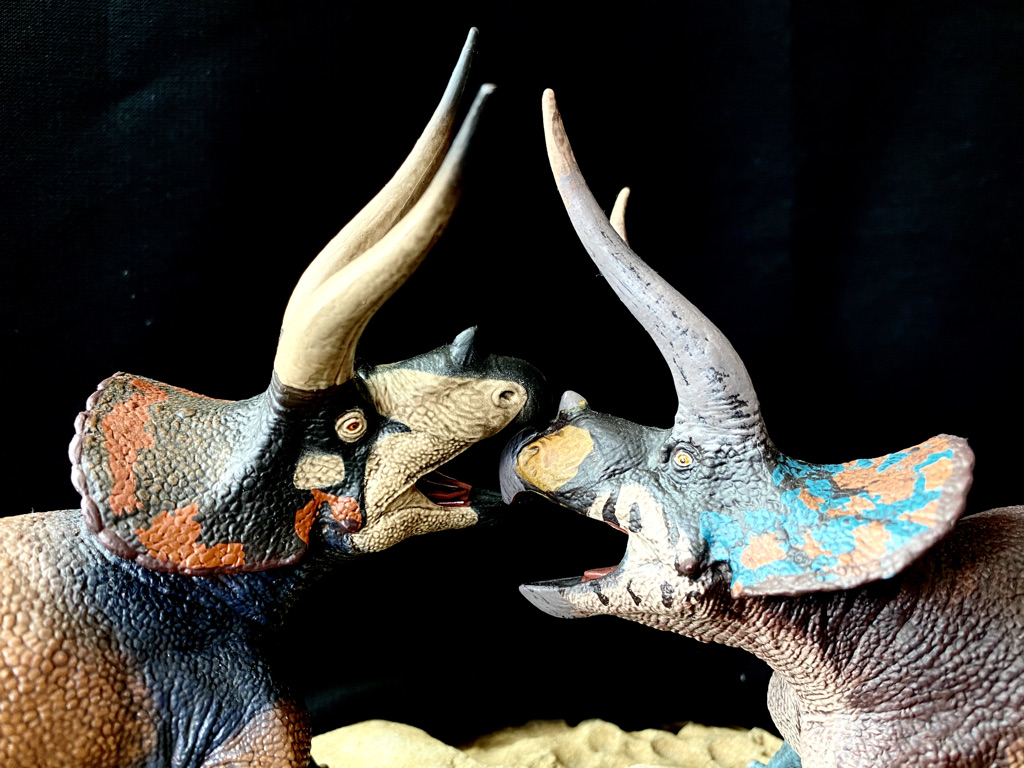
The figure is in the 1:35 scale like their two previous dinosaur figures and measures 9.25″inches long and just about 3.5″ inches tall. The 1:35 scale size is quickly replacing the old favorite 1:40, so the figure could easily fit in with the majority of the newer figures from other brands like Safari and PNSO. This model is one of those that really is worth trying to acquire both since the pose, despite being the same, is rather flexible and can easily be manipulated to have two animals in some sort of interactive activity.
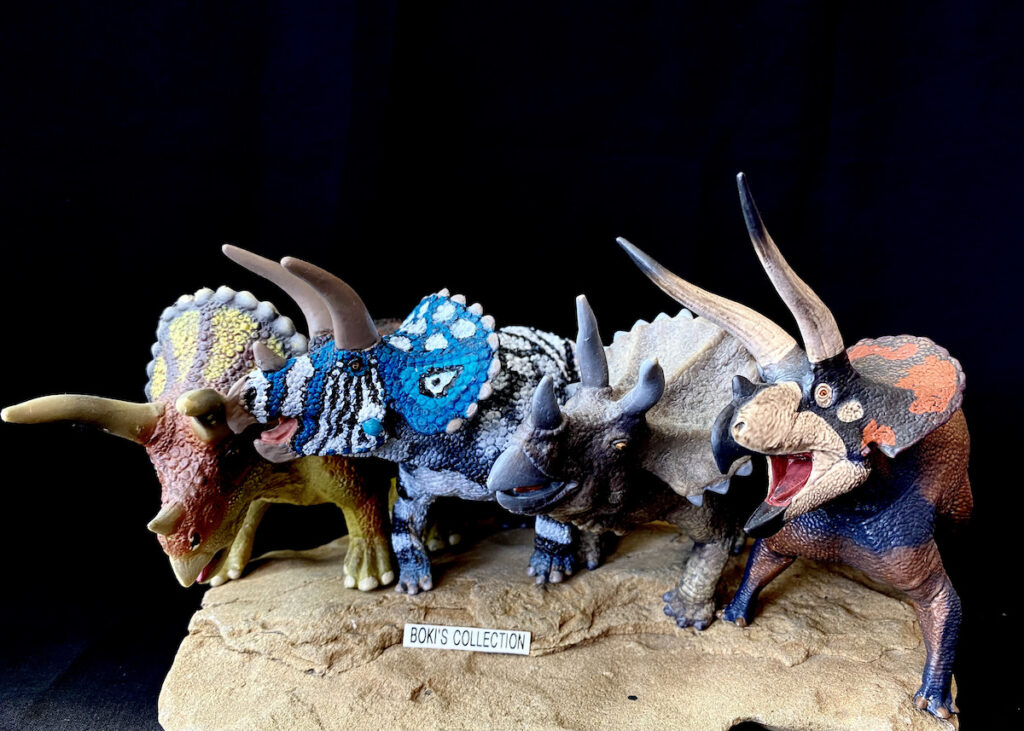
While both the Atlasaurus and Giganotosaurus (and all the prehistoric elephants for that matter) are excellent models, the skin details on these model are hard to appreciate due to the size (right scale with the figure with little exaggeration), they almost look smooth skinned from a short distance. This Triceratops on the other hand is the first to really showcase just how exquisite the detailing Eofauna is capable of.The body is covered in beautifully sculpted scales of various sizes and shape that is true to what we know of how Triceratops scales look like based on impressions on the “Lane” specimen.
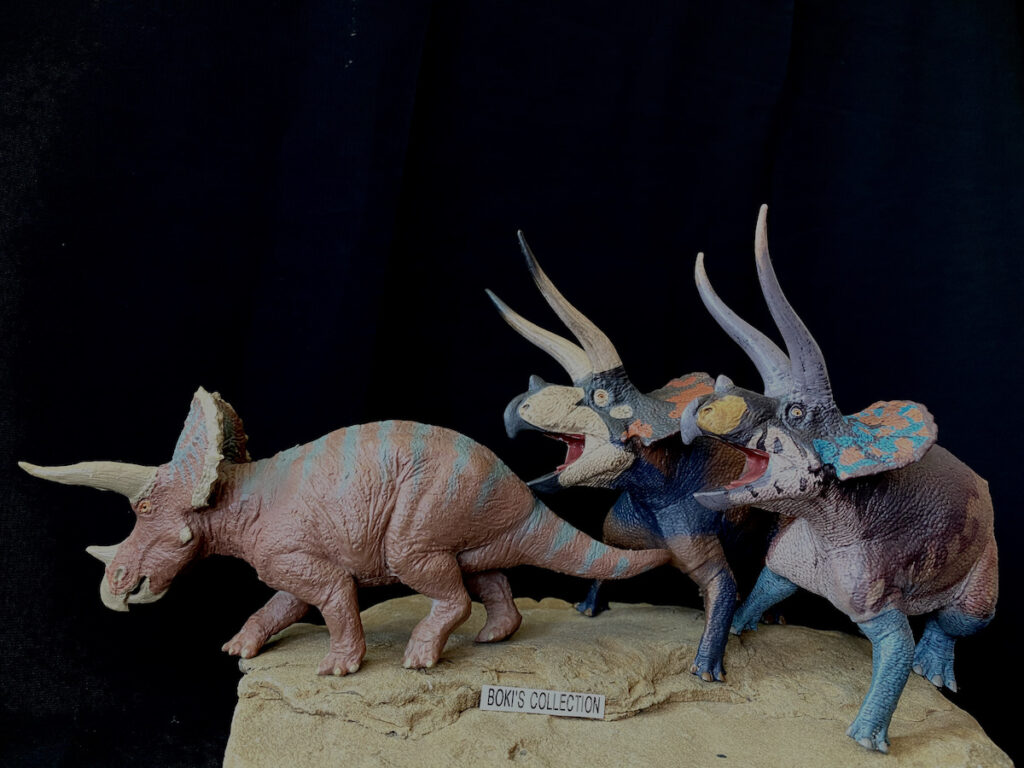
Each of these scales are individually sculpted and comes in various sizes depending on which part of the body they cover. Those on the body are hexagon in shape and large in size with knobs/tubercles mixed in here and there. As you move towards the belly, these scales are replaced by large flat scales very much like what we see in Crocodiles or Alligator. These scales are all replicated faithfully on the model and is very different on what we see on hadrosaurs or even large theropods like its Tyrannosaurus nemesis.
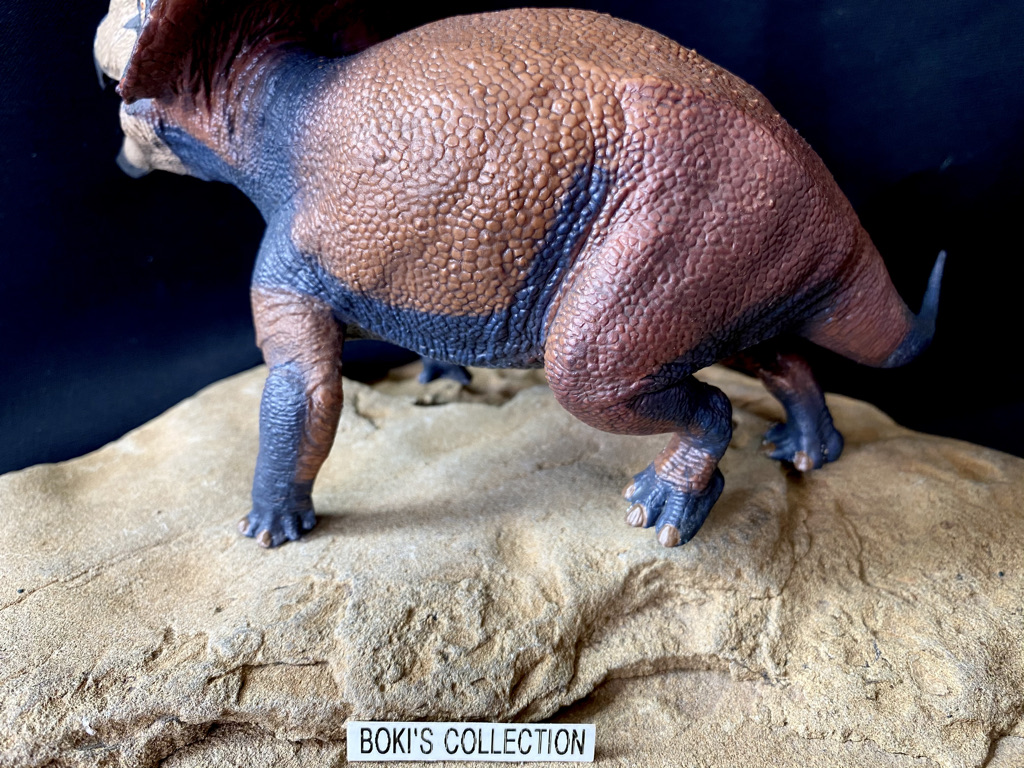
In addition to the scales, there are skin folds where you would expect to see them. On the underarms of the legs that are stretched out, you see the skin pulled as it strains giving a realistic sense of elasticity and movement.On the back of the neck you see multiple folds of skin as the animal pulls its head up and towards the side. Really realistic details such as skin folds go a long way in creating a convincing sense of tension and movement.
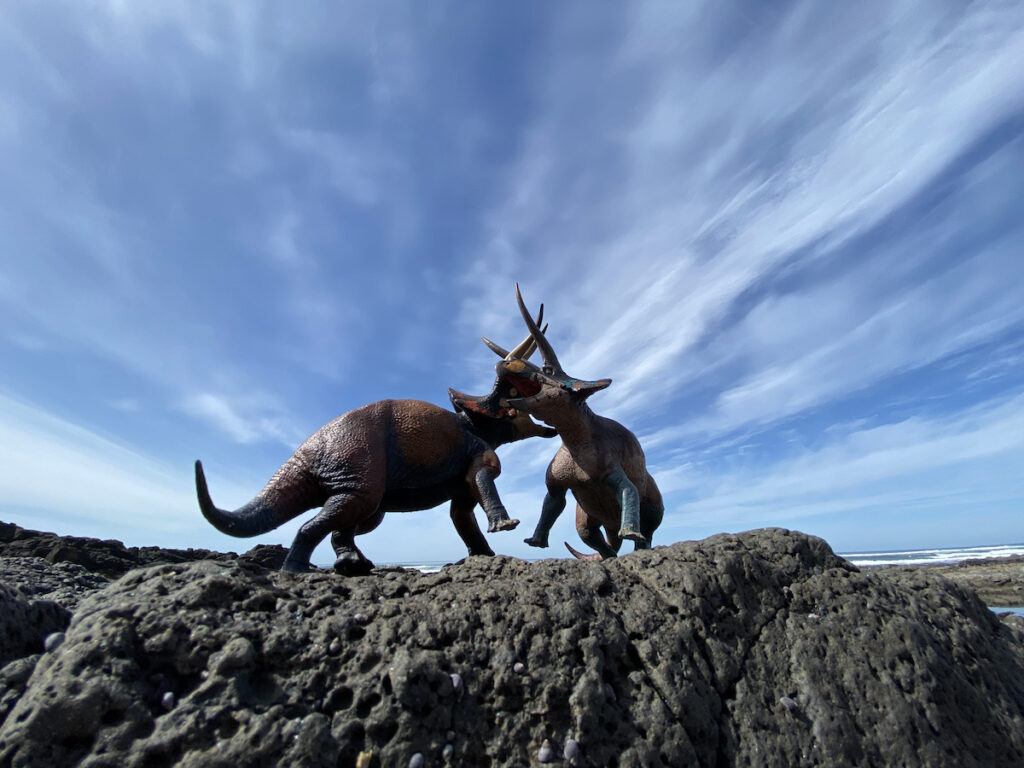
On the face, we see smaller scales covering the most of the surface that radiated up towards the impressive frill. Towards the beak and nostrils, the scales are so small it almost looks smooth unless you look really close. The frill is adorned by hornlets that are gray in color. The impressive horns are beautifully sculpted and transition very well from the base all the way to the tips. You see textures up and down the horns with the most seen on the base slowly transitioning to a more smooth, but still textured, surface the further you move up.
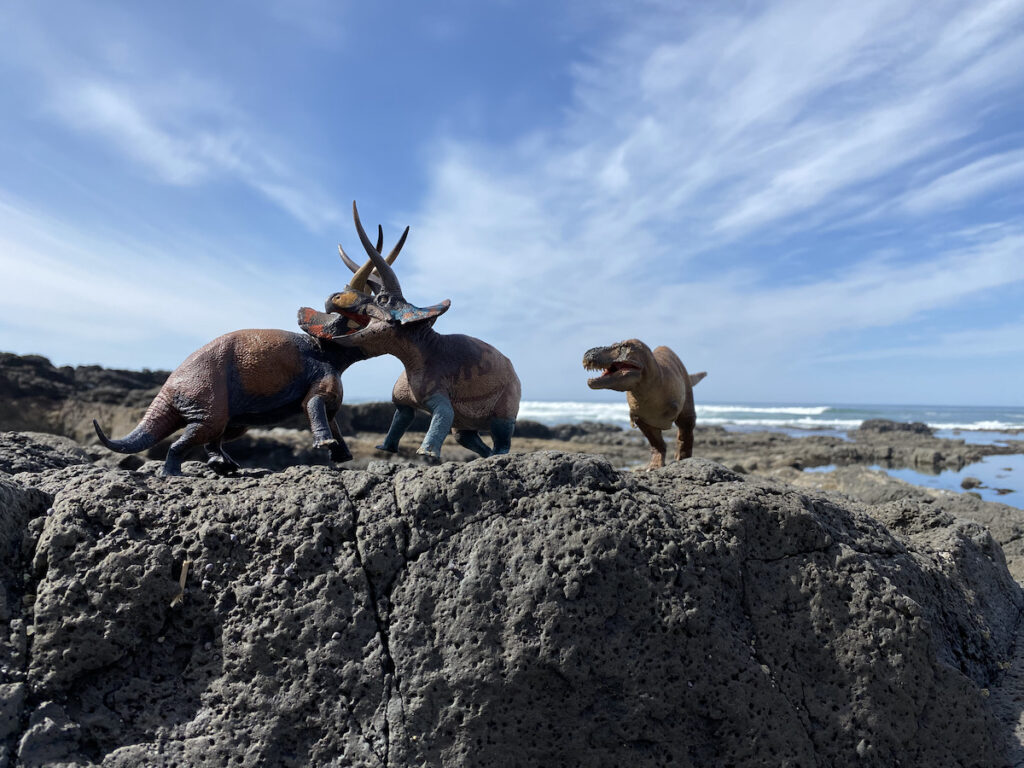
The huge brow horns juts out forward almost halfway over the head before it starts to curl back upwards in a beautiful spiral. The nose horn is small as it should be and is given a gray color. The ” Yoshi’s Triceratops” is believed to be a young animal, so it is very much possible that its horns may have grown even long if the animal had lived longer.
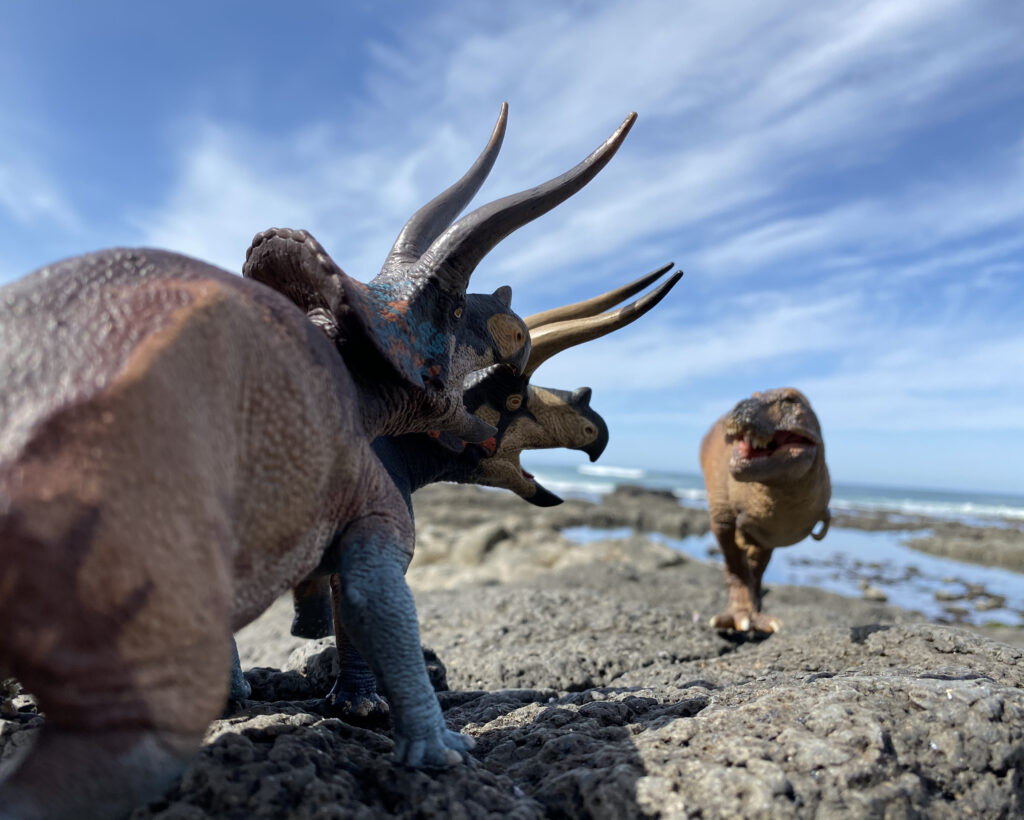
While there are other ceratopsians that have more elaborate and exotic looking horns and frill ornamentation, none of them have reached the impressive size that Triceratops achieved. Its large frill and long brow horns, massive body size, had all help make Triceratops one of the most easily recognizable of all dinosaurs and certainly the most famous ceratopsian.Triceratops is also one of the most common and last of the dinosaurs living right up until the very end.
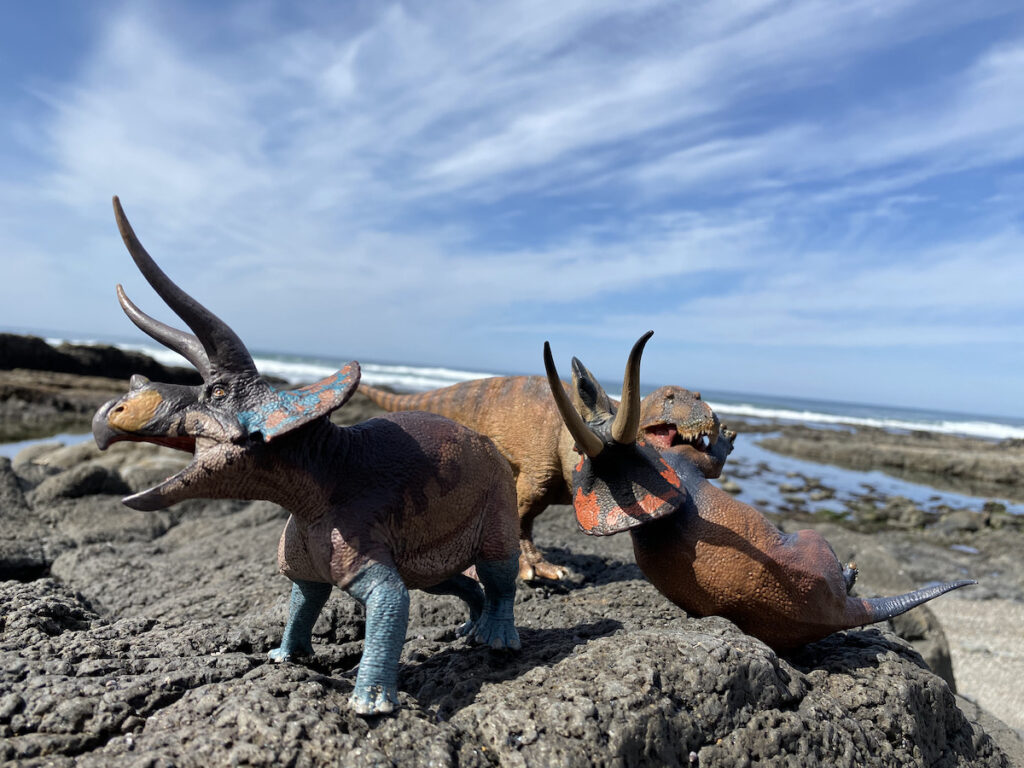
Eofauna’s Triceratops is truly a work of art that is well researched, beautifully executed, and inspired interpretation of this magnificent iconic animal. For a species that has saturated and is very well represented in the toy market for decades, it is refreshing to see a company like Eofauna still be able to breath something fresh and unique into their model.If you are able to swing it, in my opinion it is worth acquiring both version, if anything just to have a pair that really displays well and interact with each other despite being the same sculpt.
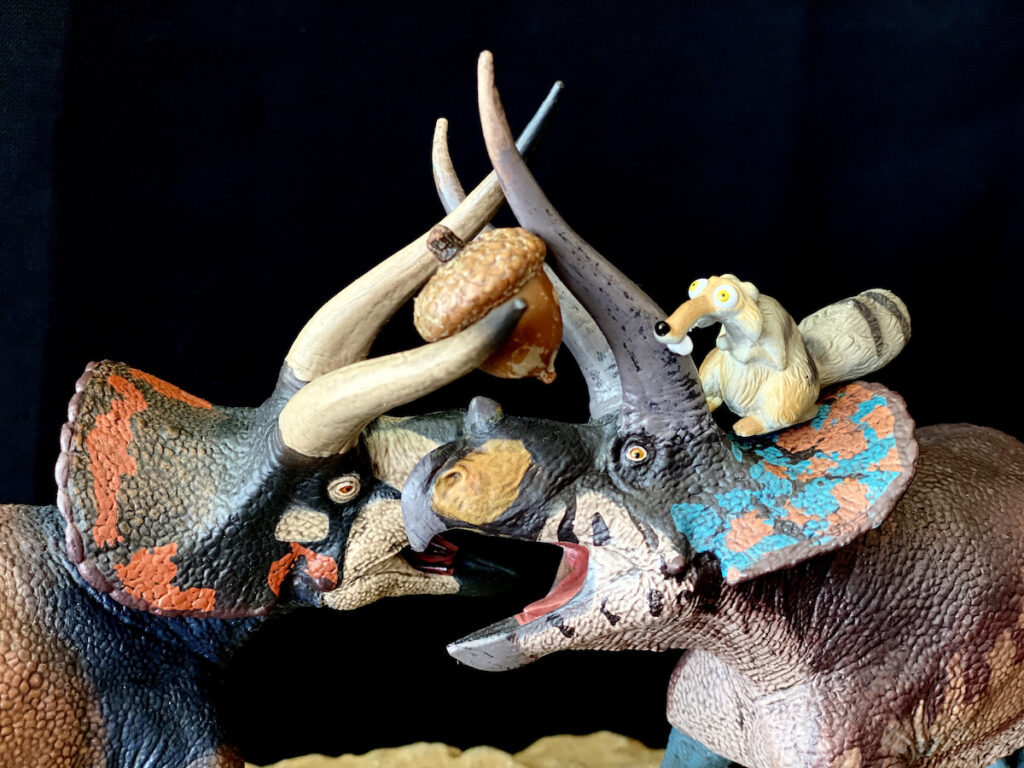
That concludes our review of Eofauna’s exquisite take on the iconic Triceratops. I hope you like it and thanks for reading the review. Until the next one, stay safe and healthy. Cheers!
Disclaimer: links to Ebay and Amazon on the DinoToyBlog are affiliate links, so we make a small commission if you use them. Thanks for supporting us!




I tend to get bored of the same taxa being made over and over, but I bought this one anyway. It’s that good.
Great review, and really great pictures. Wilson pairs well with this Trike. For some reason I’m not that excited about it though, and I think I still prefer the newer Safari and Battat Trikes. I might get this one too but I want to see what the PNSO one is like first.
Both versions are very good, I have commissioned both from Alcaiceira together with other dinosaurs and prehistoric animals from Papo, Safari and Collecta 2021. I am aware that the real figures are superior to those in the photos, even though they are photographs in this case made by Bokisasaurus and I say this for having the rest of Eofauna figures whose photographs (those of any collector and private commercial videos) do not do any justice to the real figures.
Now only the diplodocus remains! I hope they make two color versions in this case to choose from since the price I suppose will be much higher than the figures that Eofauna has used to date.
Thank you for the amazing review. I very much agree with your sentiment that this model is a work of art. EoFauna knocking it out of the park again!
Terrific reviews and photographs, especially the ones with Wilson. This is now my favourite Triceratops toy (I own the dominant version).